Local Area
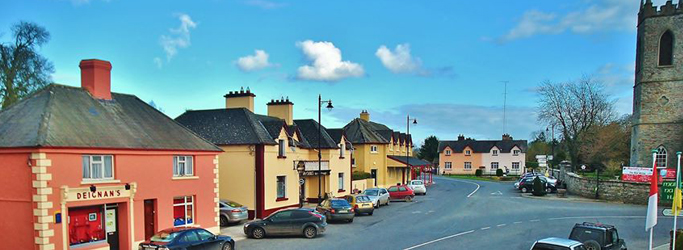
The present-day village of Moynalty replaced a village of much humbler design. The houses - mud cabins - were situated mainly where the present village is, and also on the grounds of the Roman Catholic Church. There were more of them around the area of the old cemetery. Clusters of these houses also existed along the old roadway which is still evident in the fields on the left-hand side of the road to Kells, about one kilometre from the village. They were also along the other old roadways and could be classes more as ancient manorial habitations than just one village. They are well documented in 'Not So Much To One Side' by Valentine Farrell. The old manorial village had a Catholic Church and a Catholic cemetery on the site of the later Church of Ireland church, now the Credit Union office. That same cemetery which eventually became common to Protestant as well as Catholic is long closed. The original road to Carlanstown was along the wall of the old cemetery and through the site of the house known as The Villa. Its exit was a laneway at the rear of this house.
The new village was built by the grandson of James Farrell who bought an estate around Moynalty in 1790. Most of those lands transferred to the local farmers with the Land Purchase Acts (1891-1903). That grandson, John Arthur completed the building of the present village in 1837. It is to some extent of Swiss design. Built on one side of the street only, it earned the saying 'all to one side like the village of Moynalty'.
About 100 years later houses were built on the south side. Among those original houses were two National Schools which were provided rent-free by the Farrell family.
Situated
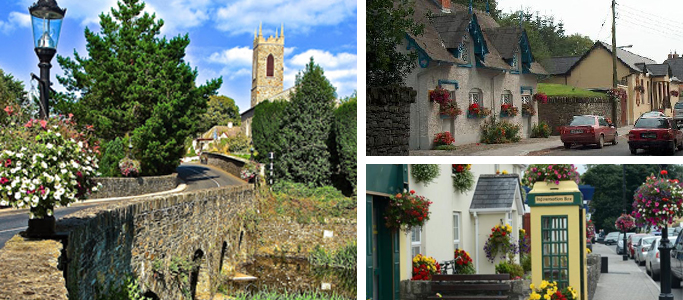
Situated opposite the cemetery between the Mullagh and Bailieborough roads is a field known locally as the 'slang', the old Gaelic word from a phrase sleann na talún, which means a parcel of land close to water or wet ground. It was bought in 1918 with anti-conscription money and today belongs to the Catholic Church. Four acres of this field was donated by the Bishop for the site of the new school which opened in 2012.
Moynalty village had a Dispensary as far back as the early 1900's. The community was well served by both midwife and doctor. The Police Barracks existed in the village centre, where Deignan's shop is now. It was burned down during the War of Independence. The house next door, presently McCormacks', was used as a courthouse periodically, and later as a forge. In the mid-1940's it became Wards' Drapery Shop. There was a small lace-making industry at Moynalty. Some of this lace was purchased by the Queen, wife of King George IV, in Buckingham Palace. She paid twenty pounds for it in 1830.
The village has become a familiar face in the National Tidy Towns Competition. Moynalty was awarded with the title of Best Kept Town in All of Ireland in 2011. In 2013 Moynalty was awarded both Tidiest Village and the overall prize for Ireland's Tidiest Town in the annual Tidy Towns Competition.
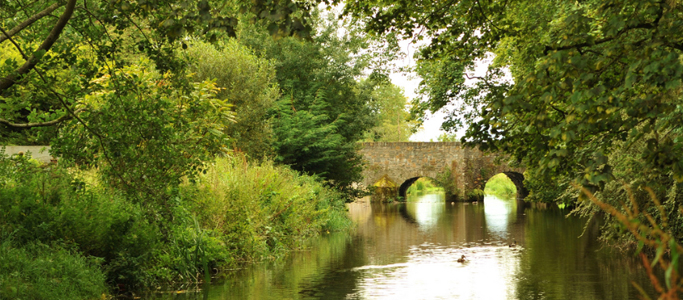
The main river that flowa through the parish of Moynalty is called the 'Borora'. The source of the river is in the vicinity of the Lough-an-Lae Mountains close to Bailieborough. Over a distance of about 11 km (7 miles) it forms a natural boundary between Meath and Cavan, and even more precisely, between Moynalty parish and County Cavan. As it meanders towards the townland of Moynalty it may sometimes be referred to as the Moynalty River. Another name for it in its upper reaches is Owenroe which in Gaelic is Abhainn Ruadh. In English that translates as Red River. The old Gaelic version of the name bequeathed to us the sonorous name Borora simply by a certain amount of mis-pronunciation in the transition from the native tongue to English.
The Borora flows along from start to finish for about 32km (20 miles) with a good gradient and speed. These factors mean that the Borora was very suitable for powering corn grinding mills. There were at least 4 mills along its banks and three eel weirs. It was in the past and it still is regarded as a vital nursery river for the whole of the Boyne system, as a very large proportion of the salmon that use the Boyne are born in the Borora. Also, it is a good trout stream and prior to arterial drainage there was a considerable pike population in the Borora too.
In the early 1980's the drainage scheme conducted by the Board of Works improved the quality of the land in the river basin, but the character of the river was changed, not altogether for the better. It lost some of its natural beauty although it still boasts the odd otter, heron, swan, wild duck and kingfisher. Gone are the safe paddling and swimming places of the good ole days!! The well-loved spot known as The Crockens where generations of children splashed, played and learned to swim has disappeared. Nobody goes there anymore, the price paid for progress. With time, lost beauty is returning as nature regenerates itself battling with the real presence of pollution, both industrial and agricultural. Hopefully future generations will cherish and respect this vital artery of Moynalty parish and protect it for posterity.
As it flows gently on its course towards the sea, it discharges into the Meath Blackwater at Bloomsbury, south of Kells. Journeying on its way more vigorously now, it leaves far behind the red sandstone which gave it the name Abhainn Ruadh a long time ago.
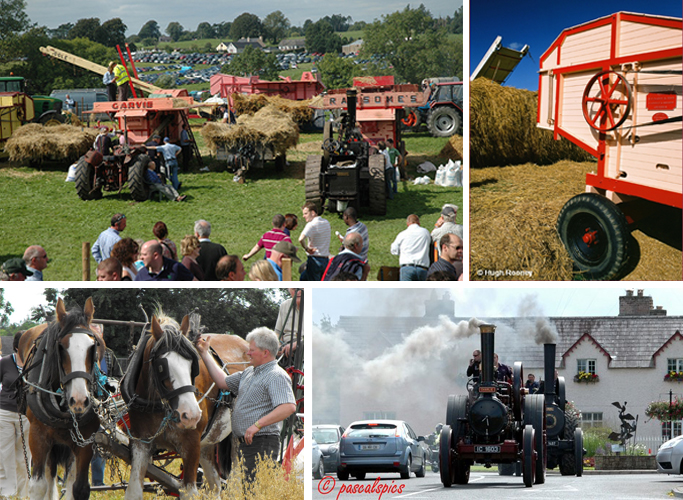
The village also hosts the Annual Moynalty Steam Threshing festival, held every August since 1976. It is the longest running Agricultural Show in Ireland. Moynalty Steam Threshing is a community festival run by volunteers in aid of the community and many different charities. The first Threshing was held in 1976 to raise funds for the Church extension, a profit of £1,000 was made on a wet Sunday afternoon. The event has grown from strength to strength since and has an annual attendance in excess of 30,000.
The Moynalty Steam Threshing Festival is a celebration of days gone by, of horse and steam power, vintage displays, trading stalls, dog show and sideshows. Country living of bygone years is uniquely presented and re-enacted in a series of demonstrations and displays. The Museum houses a vast display of antiquities. Exhibitors of veteran tractors, steam engines, cars, horse drawn machinery and stationary engines travel from all over the country.
In the cornfield 6 acres of oats is reaped using the horse drawn reaper and binder and the sheaves stooked and brought to the mills in the festival field for threshing. Here the exhibition of threshing by steam engines, horse, flail and tractor is the centrepiece of the afternoon. Young and old delight in seeing the mighty engines billowing smoke sky high whilst filling the sacks with oats and clearing the straw. This year Harry Rowntree with his McLaren steam engine will lead the parade through the village followed by vintage tractors and cars at 12.30.
At the thatched cottage on the hill many time-honoured crafts are demonstrated, churning, basketry, woodturning, thatching, blacksmithing, harness making and spinning. On the hobs pancakes, brown bread, boxty and colcannon are cooked (Irish style) with samples for eating and buying. Delicious roast pig can be sampled later. There's a water wheel on the Borora River and mud turf is run on the bank.
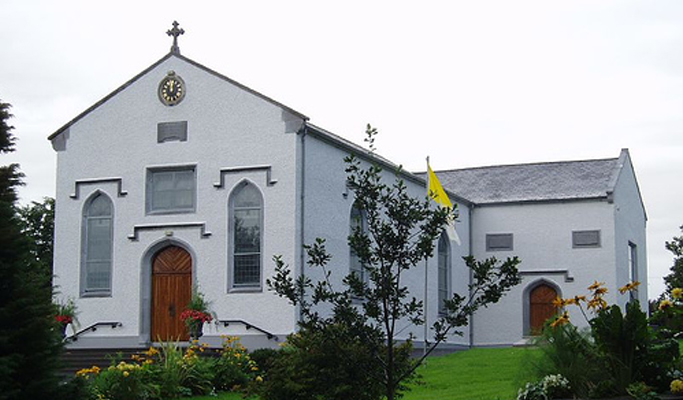
The Church of the Assumption, Moynalty, was built in 1820. In 1819 the Catholic landlord of Moynalty, John Farrell, donated an acre of land for the site of a parish church. He also donated a substantial sum of money towards the building of the church, which cost £1,000.
In 1865 a stained-glass window was installed in the sanctuary of Moynalty Church depicting three scenes, the Nativity, Calvary and the Assumption of Our Lady. It is of French origin. This window was completely restored and storm-glazed by the Abbey Stained Glass Studios, Dublin, in 1999. The cost of the work was £10,000 at the time which was sponsored by Moynalty Steam Threshing Committee.
In 1910 the church was extended by adding an apse and two sacristies. At the same time three marble altars were erected and a new belfry and bell were donated. In 1916 the cross on the front of the church, installed in 1820, was found to be too heavy for the walls to support, so it was taken down and re-erected in the centre of St. Mary's Cemetery, where it still stands. Hence the two dates on the cross, 1820 and 1916.
In 1976 an extension was added to the nave of the church.
In 1994 the Mass Rock which was located on the Rountree property at Curraghtown was donated to the parish and is now installed in the church grounds.
In 1996 a cross stone retrieved from the site of the old church in Rathbawn was offered to Moynalty parish by Mrs. Dorothy de Stacpoole. It is dated 1812. The cross is now in the church grounds, Moynalty.

Moynalty is very fortunate to have fantastic Tennis facilities in the heart of the village. There are two courts with all weather surface situated along the banks of the Borora. There is a lovely walkway around the Threshing field and outdoor exercise equipment free to public use.
In July 1999, a group of people from the parish came together to discuss ways to mark the end of the old millennium and the beginning of the new.
A place, any place is, really about its people, and so it was decided to assemble a photographic record of the families in Moynalty. The group mapped and profiled each townland with its history and the families who belonged there. The book also focuses on the religious aspect of the parish and the significance of the Jubilee Year. The book looks at the schools both past & present, and also at the many clubs, groups and organisations which existed in the past or are continuing to thrive within our community today.
Many stories, yarns and folklore was gathered as the work progressed. There is a wealth of information compiled into the pages of the Millennium Record. It gives the reader a sense of Moynalty, its people and its community spirit as they journey through the pages and relieve many memories.
This book is already a very valuable record in homes throughout the parish and will continue to give an insight for future generations into our parish and community as it was at the turn of the 20th Century.
The Yoga Festival





